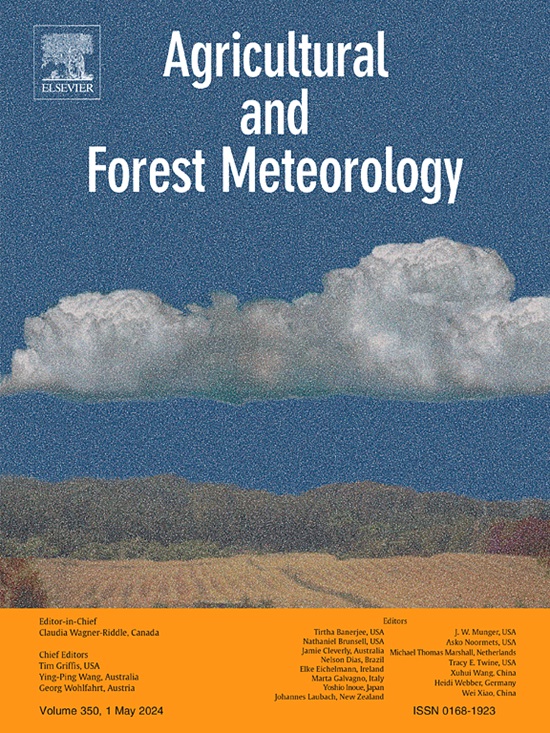入侵植物对地中海沿岸生态系统小气候和水分胁迫影响的遥感评估
IF 5.7
1区 农林科学
Q1 AGRONOMY
引用次数: 0
摘要
本研究利用多源、多时间点遥感影像,比较了入侵植物刺槐(Heterotheca subaxillaris)和刺槐(Acacia saligna)与天然植被对以色列沿海平原小气候条件的影响。入侵物种和其他土地覆盖的分类和制图的总体精度为85%,使用深秋图像观察到最佳性能。在自然面积中,原生植被占45%,灌木占30%,盐渍草占15%,裸土/砂占10%。定量分析表明,与原生地植被相比,雨蒿的地表温度春季升高0.6℃,夏季升高1.8℃,秋季升高2.19℃。该物种还增加了水蒸气和潜在蒸散量,同时减少了土壤蒸发和植被遮阳,导致直接和间接的水分胁迫。相比之下,盐渍草由于植被密度高和遮荫,提供了局部降温,但其高同化和蒸腾速率导致水蒸气、日总蒸发量和PET升高,间接放大了水分胁迫。原生植被通过降低温度和水汽来调节当地小气候,同时在整个旱季保持稳定的蒸散量和低水分胁迫。本研究强调了入侵物种与小气候条件之间复杂的相互作用,强调了遥感技术在监测和管理这些物种中的关键作用。通过将遥感图像与详细的小气候分析相结合,它为入侵物种对地中海沿岸生态系统的温度制度、水分胁迫和蒸散作用的对比生态影响提供了新的见解。本文章由计算机程序翻译,如有差异,请以英文原文为准。
Remote sensing assessment of invasive plant species impacts on microclimate and water stress in mediterranean coastal ecosystems
This study uses multi-source, multi-temporal remote sensing imagery to compare the effects of invasive Heterotheca subaxillaris and Acacia saligna and natural vegetation on microclimate conditions in Israeli coastal plain. The overall accuracy of the classification and mapping of invasive species and other land covers was 85 %, with optimal performance observed using late autumn imagery. Among the natural areas, 45 % were occupied by native vegetation, 30 % by H. subaxillaris, 15 % by A. saligna and 10 % by bare soil/sand.
Quantitative analysis revealed that H. subaxillaris, consistently elevated surface temperatures by 0.6 °C in spring, 1.8 °C in summer and 2.19 °C in autumn compared to native vegetation. This species also increased water vapor and potential evapotranspiration, while reducing soil evaporation and vegetation shading, resulting in both direct and indirect contributions to water stress. In contrast, A. saligna, provided localized cooling due to high vegetation density and shading, yet its high assimilation and transpiration rates led to elevated water vapor, daily total evaporation and PET indirectly amplifying water stress. Native vegeation moderated the local microclimate by decreasing temperature and water vapor, while maintaining stable evapotranspiration and low water stress throughout the dry season. This study highlights the complex interactions between invasive species and microclimate conditions, emphasizing the critical role of remote sensing techniques in monitoring and managing these species. By integrating remote sensing imagery with detailed microclimatic analysis, it provides novel insights into the contrasting ecological impacts of invasive species on temperature regimes, water stress, and evapotranspiration in Mediterranean coastal ecosystems.
求助全文
通过发布文献求助,成功后即可免费获取论文全文。
去求助
来源期刊
CiteScore
10.30
自引率
9.70%
发文量
415
审稿时长
69 days
期刊介绍:
Agricultural and Forest Meteorology is an international journal for the publication of original articles and reviews on the inter-relationship between meteorology, agriculture, forestry, and natural ecosystems. Emphasis is on basic and applied scientific research relevant to practical problems in the field of plant and soil sciences, ecology and biogeochemistry as affected by weather as well as climate variability and change. Theoretical models should be tested against experimental data. Articles must appeal to an international audience. Special issues devoted to single topics are also published.
Typical topics include canopy micrometeorology (e.g. canopy radiation transfer, turbulence near the ground, evapotranspiration, energy balance, fluxes of trace gases), micrometeorological instrumentation (e.g., sensors for trace gases, flux measurement instruments, radiation measurement techniques), aerobiology (e.g. the dispersion of pollen, spores, insects and pesticides), biometeorology (e.g. the effect of weather and climate on plant distribution, crop yield, water-use efficiency, and plant phenology), forest-fire/weather interactions, and feedbacks from vegetation to weather and the climate system.

 求助内容:
求助内容: 应助结果提醒方式:
应助结果提醒方式:


